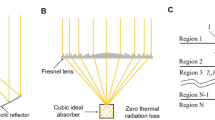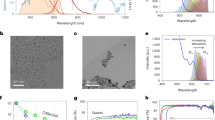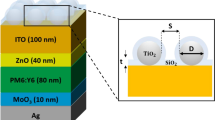Abstract
Luminescent solar concentrators (LSCs) can serve as large-area sunlight collectors for terrestrial and space-based photovoltaics. Due to their high emission efficiencies and readily tunable emission and absorption spectra, colloidal quantum dots have emerged as a new and promising type of LSC fluorophore. Spectral tunability of the quantum dots also facilitates the realization of stacked multilayered LSCs, where enhanced performance is obtained through spectral splitting of incident sunlight, as in multijunction photovoltaics. Here, we demonstrate a large-area (>230 cm2) tandem LSC based on two types of nearly reabsorption-free quantum dots spectrally tuned for optimal solar-spectrum splitting. This prototype device exhibits a high optical quantum efficiency of 6.4% for sunlight illumination and solar-to-electrical power conversion efficiency of 3.1%. The efficiency gains due to the tandem architecture over single-layer devices quickly increase with increasing LSC size and can reach more than 100% in structures with window sizes of more than 2,500 cm2.
This is a preview of subscription content, access via your institution
Access options
Access Nature and 54 other Nature Portfolio journals
Get Nature+, our best-value online-access subscription
$29.99 / 30 days
cancel any time
Subscribe to this journal
Receive 12 print issues and online access
$209.00 per year
only $17.42 per issue
Buy this article
- Purchase on Springer Link
- Instant access to full article PDF
Prices may be subject to local taxes which are calculated during checkout




Similar content being viewed by others
References
Weber, W. & Lambe, J. Luminescent greenhouse collector for solar radiation. Appl. Opt. 15, 2299–2300 (1976).
Batchelder, J. S., Zewail, A. H. & Cole, T. Luminescent solar concentrators. 1. Theory of operation and techniques for performance evaluation. Appl. Opt. 18, 3090–3110 (1979).
Currie, M. J., Mapel, J. K., Heidel, T. D., Goffri, S. & Baldo, M. A. High-efficiency organic solar concentrators for photovoltaics. Science 321, 226–228 (2008).
Debije, M. G. & Verbunt, P. P. C. Thirty years of luminescent solar concentrator research: solar energy for the built environment. Adv. Energ. Mater. 2, 12–35 (2012).
van Sark, W. G. J. H. M. et al. Luminescent solar concentrators—a review of recent results. Opt. Express 16, 21773–21792 (2008).
Li, H., Wu, K., Lim, J., Song, H.-J. & Klimov, V. I. Doctor-blade deposition of quantum dots onto standard window glass for low-loss large-area luminescent solar concentrators. Nat. Energy 1, 16157 (2016).
Meinardi, F. et al. Highly efficient large-area colourless luminescent solar concentrators using heavy-metal-free colloidal quantum dots. Nat. Nanotech. 10, 878–885 (2015).
Zhao, Y. & Lunt, R. R. Transparent luminescent solar concentrators for large-area solar windows enabled by massive Stokes-shift nanocluster phosphors. Adv. Energ. Mater. 3, 1143–1148 (2013).
Sholin, V., Olson, J. D. & Carter, S. A. Semiconducting polymers and quantum dots in luminescent solar concentrators for solar energy harvesting. J. Appl. Phys. 101, 123114 (2007).
Vossen, F. M., Aarts, M. P. J. & Debije, M. G. Visual performance of red luminescent solar concentrating windows in an office environment. Energy Build. 113, 123–132 (2016).
Pritchard, J., Simon, K., Dowd, C. & Joshi, E. Solar power concentrators for space applications. PAM Rev. Energy Sci. Tech. 3, 2–26 (2016).
Cambié, D., Zhao, F., Hessel, V., Debije, M. G. & Noël, T. A leaf-inspired luminescent solar concentrator for energy-efficient continuous-flow photochemistry. Angew. Chem. Int. Ed. 56, 1050–1054 (2017).
Wilson, L. R., Klampaftis, E. & Richards, B. S. Enhancement of power output from a large-area luminescent solar concentrator with 4.8× concentration via solar cell current matching. IEEE J. Photovolt. 7, 802–809 (2017).
Zhao, Y., Meek, G. A., Levine, B. G. & Lunt, R. R. Near-infrared harvesting transparent luminescent solar concentrators. Adv. Opt. Mater. 2, 606–611 (2014).
Gutierrez, G. D., Coropceanu, I., Bawendi, M. G. & Swager, T. M. A low reabsorbing luminescent solar concentrator employing π-conjugated polymers. Adv. Mater. 28, 497–501 (2016).
Nikolaidou, K. et al. Hybrid perovskite thin films as highly efficient luminescent solar concentrators. Adv. Opt. Mater. 4, 2126–2132 (2016).
Zhao, H., Zhou, Y., Benetti, D., Ma, D. & Rosei, F. Perovskite quantum dots integrated in large-area luminescent solar concentrators. Nano Energy 37, 214–223 (2017).
Pietryga, J. M. et al. Spectroscopic and device aspects of nanocrystal quantum dots. Chem. Rev. 116, 10513–10622 (2016).
Klimov, V. I., Baker, T. A., Lim, J., Velizhanin, K. A. & McDaniel, H. Quality factor of luminescent solar concentrators and practical concentration limits attainable with semiconductor quantum dots. ACS Photon. 3, 1138–1148 (2016).
Li, C. et al. Large Stokes shift and high efficiency luminescent solar concentrator incorporated with CuInS2/ZnS quantum dots. Sci. Rep. 5, 17777 (2015).
Bronstein, N. D. et al. Quantum dot luminescent concentrator cavity exhibiting 30-fold concentration. ACS Photon. 2, 1576–1583 (2015).
Erickson, C. S. et al. Zero-reabsorption doped-nanocrystal luminescent solar concentrators. ACS Nano 8, 3461–3467 (2014).
Coropceanu, I. & Bawendi, M. G. Core/shell quantum dot based luminescent solar concentrators with reduced reabsorption and enhanced efficiency. Nano Lett. 14, 4097–4101 (2014).
Krumer, Z. et al. Tackling self-absorption in luminescent solar concentrators with type-II colloidal quantum dots. Sol. Energy Mater. Sol. Cells 111, 57–65 (2013).
Bradshaw, L. R., Knowles, K. E., McDowall, S. & Gamelin, D. R. Nanocrystals for luminescent solar concentrators. Nano Lett. 15, 1315–1323 (2015).
Meinardi, F. et al. Large-area luminescent solar concentrators based on ‘Stokes-shift-engineered’ nanocrystals in a mass-polymerized PMMA matrix. Nat. Photon. 8, 392–399 (2014).
Zhou, Y. et al. Near infrared, highly efficient luminescent solar concentrators. Adv. Energ. Mater. 6, 1501913 (2016).
Meinardi, F. et al. Highly efficient luminescent solar concentrators based on earth-abundant indirect-bandgap silicon quantum dots. Nat. Photon. 11, 177–185 (2017).
Knowles, K. E., Kilburn, T. B., Alzate, D. G., McDowall, S. & Gamelin, D. R. Bright CuInS2/CdS nanocrystal phosphors for high-gain full-spectrum luminescent solar concentrators. Chem. Commun. 51, 9129–9132 (2015).
Tummeltshammer, C. et al. On the ability of Förster resonance energy transfer to enhance luminescent solar concentrator efficiency. Nano Energy 32, 263–270 (2017).
Santra, P. K. & Kamat, P. V. Tandem-layered quantum dot solar cells: tuning the photovoltaic response with luminescent ternary cadmium chalcogenides. J. Am. Chem. Soc. 135, 877–885 (2013).
Takamoto, T., Ikeda, E., Kurita, H. & Ohmori, M. Over 30% efficient InGaP/GaAs tandem solar cells. Appl. Phys. Lett. 70, 381–383 (1997).
Vos, A. D. Detailed balance limit of the efficiency of tandem solar cells. J. Phys. D 13, 839 (1980).
Chatten, A. J., Barnham, K. W. J., Buxton, B. F., Ekins-Daukes, N. J. & Malik, M. A. A new approach to modelling quantum dot concentrators. Sol. Energy Mater. Sol. Cells 75, 363–371 (2003).
Goetzberger, A. & Greube, W. Solar energy conversion with fluorescent collectors. Appl. Phys. 14, 123–139 (1977).
Rice, W. D., McDaniel, H., Klimov, V. I. & Crooker, S. A. Magneto-optical properties of CuInS2 nanocrystals. J. Phys. Chem. Lett. 5, 4105–4109 (2014).
Knowles, K. E., Nelson, H. D., Kilburn, T. B. & Gamelin, D. R. Singlet–triplet splittings in the luminescent excited states of colloidal Cu+:CdSe, Cu+:InP, and CuInS2 nanocrystals: charge-transfer configurations and self-trapped excitons. J. Am. Chem. Soc. 137, 13138–13147 (2015).
Rurack, K. & Spieles, M. Fluorescence quantum yields of a series of red and near-infrared dyes emitting at 600−1000 nm. Anal. Chem. 83, 1232–1242 (2011).
Zang, H. et al. Thick-shell CuInS2/ZnS quantum dots with suppressed ‘blinking’ and narrow single-particle emission line widths. Nano Lett. 17, 1787–1795 (2017).
McDaniel, H. et al. Simple yet versatile synthesis of CuInSe x S2–x quantum dots for sunlight harvesting. J. Phys. Chem. C 118, 16987–16994 (2014).
Yarema, O. et al. Highly luminescent, size- and shape-tunable copper indium selenide based colloidal nanocrystals. Chem. Mater. 25, 3753–3757 (2013).
Slooff, L. H. et al. A luminescent solar concentrator with 7.1% power conversion efficiency. Phys. Status Solidi Rapid Res. Lett. 2, 257–259 (2008).
Beaulac, R., Archer, P. I. & Gamelin, D. R. Luminescence in colloidal Mn2+-doped semiconductor nanocrystals. J. Solid State Chem. 181, 1582–1589 (2008).
Levchuk, I. et al. Industrially scalable and cost-effective Mn2+ doped Zn x Cd1−x S/ZnS nanocrystals with 70% photoluminescence quantum yield, as efficient down-shifting materials in photovoltaics. Energy Environ. Sci. 9, 1083–1094 (2016).
Zhao, H. et al. Absorption enhancement in ‘giant’ core/alloyed-shell quantum dots for luminescent solar concentrator. Small 12, 5354–5365 (2016).
Sumner, R. et al. Analysis of optical losses in high-efficiency CuInS2-based nanocrystal luminescent solar concentrators: balancing absorption versus scattering. J. Phys. Chem. C 121, 3252–3260 (2017).
Bomm, J. et al. Fabrication and full characterization of state-of-the-art quantum dot luminescent solar concentrators. Sol. Energy Mater. Sol. Cells 95, 2087–2094 (2011).
Goldschmidt, J. C. et al. Increasing the efficiency of fluorescent concentrator systems. Sol. Energy Mater. Sol. Cells 93, 176–182 (2009).
Green, M. A., Emery, K., Hishikawa, Y., Warta, W. & Dunlop, E. D. Solar cell efficiency tables (version 42). Prog. Photovolt. Res. Appl. 21, 827–837 (2013).
Panthani, M. G. et al. CuInSe2 quantum dot solar cells with high open-circuit voltage. J. Phys. Chem. Lett. 4, 2030–2034 (2013).
Du, J. et al. Zn-Cu-In-Se quantum dot solar cells with a certified power conversion efficiency of 11.6%. J. Am. Chem. Soc. 138, 4201–4209 (2016).
Li, L. et al. Efficient synthesis of highly luminescent copper indium sulfide-based core/shell nanocrystals with surprisingly long-lived emission. J. Am. Chem. Soc. 133, 1176–1179 (2011).
Zhang, A. et al. Non-blinking (Zn)CuInS/ZnS quantum dots prepared by in situ interfacial alloying approach. Sci. Rep. 5, 15227 (2015).
Acknowledgements
This work was supported by the Centre for Advanced Solar Photophysics (CASP), an Energy Frontier Research Centre funded by the US Department of Energy, Office of Science, Basic Energy Sciences. K.W. is a CASP member supported by a LANL Director’s Postdoctoral Fellowship.
Author information
Authors and Affiliations
Contributions
K.W. and V.I.K. conceived the idea and designed the experiments. H.L. synthesized CuInSe2/ZnS quantum dots. K.W. synthesized Mn2+-doped CdZnS/ZnS quantum dots. H.L. performed microstructural characterizations and stability measurements of the quantum dots. K.W. fabricated and measured the LSC devices and analysed the data. K.W. and V.I.K. wrote the manuscript.
Corresponding author
Ethics declarations
Competing interests
The authors declare no competing financial interests.
Additional information
Publisher’s note: Springer Nature remains neutral with regard to jurisdictional claims in published maps and institutional affiliations.
Supplementary information
Supplementary Information
Supplementary Notes 1–5; Supplementary Figures 1–17; Supplementary Tables 1–7; Supplementary References 1–19.
Rights and permissions
About this article
Cite this article
Wu, K., Li, H. & Klimov, V.I. Tandem luminescent solar concentrators based on engineered quantum dots. Nature Photon 12, 105–110 (2018). https://doi.org/10.1038/s41566-017-0070-7
Received:
Accepted:
Published:
Issue Date:
DOI: https://doi.org/10.1038/s41566-017-0070-7
This article is cited by
-
Multifunctional photon conversion materials for enhancing silicon solar cells
Light: Science & Applications (2024)
-
A comprehensive dataset of photonic features on spectral converters for energy harvesting
Scientific Data (2024)
-
Luminescent solar concentrator efficiency enhanced via nearly lossless propagation pathways
Nature Photonics (2024)
-
Synthesis and Modulation of Low-Dimensional Transition Metal Chalcogenide Materials via Atomic Substitution
Nano-Micro Letters (2024)
-
Near-infrared photon upconversion and solar synthesis using lead-free nanocrystals
Nature Photonics (2023)



